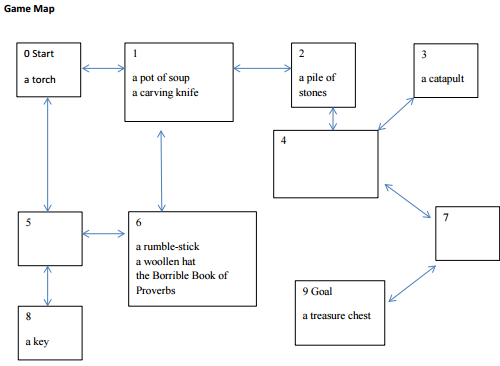Reference no: EM13748718
Assignment - Development of a Simple Menu Driven Text Adventure
Project Overview
For this assignment you will be provided with incomplete sample starter code that you can modify and build upon. Your task will be to carry out the design, analysis, coding and testing to add several additional features to this sample code. You are expected to fully comment the provided code as well as your own code. This project will implement a simple menu-driven text adventure. Text adventure games were very popular in the early days of computer gaming, as they could run even on low-end computer systems which could not support advanced graphics. The player controlled a character within an environment such as a fantasy castle or a spaceship.
The environment was made up of a series of interconnected locations, which were described to the player by written descriptions. By entering short text commands such as "go north" or "get key" the player could explore these locations, pick up and use objects within the environment, fight enemies and so on. Generally the player had to solve a series of puzzles to enable them to achieve a goal in the game such as reaching a goal location where treasure was stored. Many of the classic text adventures are now freely available online, so if you are interested you may want to try some of them:
• Colossal Cave (the first text adventure):
• The Hobbit (made in Melbourne!):
Developing a complete text adventure is too challenging at this stage of the course, so we will make a number of simplifications:
• To avoid having to process commands made up of one or more words, all user input will be through a numeric menu.
• Interaction with objects in the game will be very limited.
The provided partial solution source code implements some fundamental aspects of the text adventure:
• The use of arrays (both 1D and 2D) to store information about the map which defines the game world, the descriptions of locations, and the description and location of game objects
• A simple numeric menu which the player uses to enter commands
• The ability for the player to move between locations in the game world by moving in the four cardinal compass directions (north, east, south and west)
Project Specification
Your task will be to first answer some questions testing your comprehension of the partial solution, and then to
extend this partial solution to provide additional features:
1. Answer the questions listed below under Part A - save your answers into a Word document for submission along with remainder of your assignment.
2. Design your own unique game world, which must exhibit the following characteristics:
a. It should consist of between 10 and 20 interconnected locations (please don't exceed this limit as it will slow down the marking process)
b. All eight possible directions of movement (N, S, E, W, NE, SE, SW, NW) must be used at least once in the game map.
c. The world should contain 10 objects. At least one location must contain no objects, and at least one location must contain multiple objects.
d. Every location and object must have its own unique description.
e. There must be a specified ‘goal' location which the player is aiming to reach - this will be used later within Stage 6 of the project.
Your design should be clearly documented in the form of a world map and table of descriptions similar to the example provided on moodle.
3. Extend the menu and related code so that the player can also move in the ordinal directions (northeast, south-east, south-west, north-west)
4. Modify the program code and data so as to implement the game world designed in Stage 2.
5. Add a ‘quit' option to the menu, and modify the loop in the main() method so that it exits if the user enters this command.
6. Further modify the loop so that it exits and displays a suitable congratulatory message if the player reaches a specific ‘goal' location within the game-world.
7. Modify the room description method so that the player automatically picks up any objects in their current location. If the room description is redisplayed, those objects should no longer be listed as being in that location (hint: use a special value such as -1 to indicate that an object is in the player's possession).
8. Add an additional ‘inventory' command to the menu and implement a method which is called when this command is entered, which will list all of the objects currently in the player's possession.
9. Now that no further commands will be added to the menu, modify the menu code to ensure that a valid selection has been made by the player. If not, display an error message and prompt them to enter a new value. Repeat this until valid input is obtained.
10. This is the most advanced aspect of the project - do not attempt this unless you have all the other requirements working. Modify the program code so that the goal location cannot be entered unless the player is carrying a particular object (e.g. a key). If the player tries to enter the room without this object then an appropriate message should be displayed. For full marks for this section, your solution should be easily applicable to other game worlds (for example worlds with multiple locked doors).
